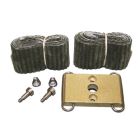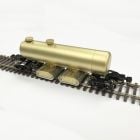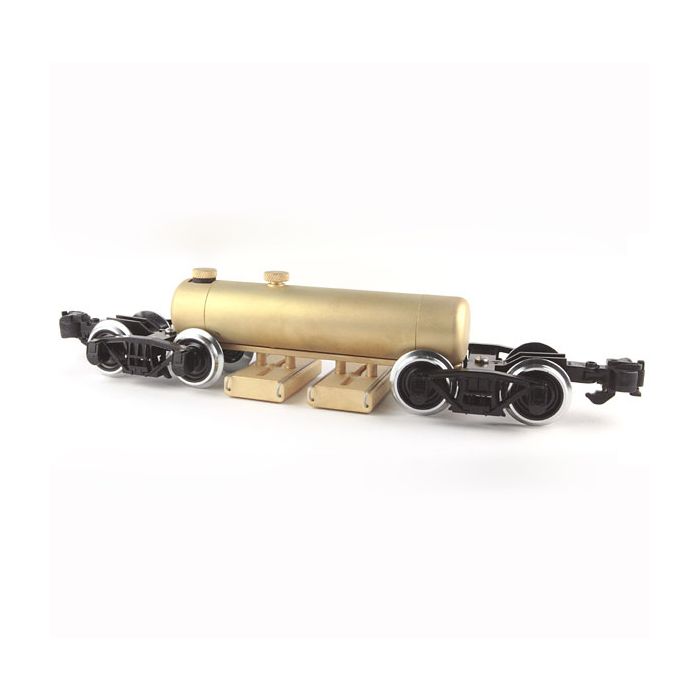CMX Clean Machine, Track Cleaning Car, G Scale
We should have these back
in stock by late 2nd Qtr 2024
Clean Machine™ for G scale 2 Rail.
- CMX Manual with Chemist’s Review (PDF)
- CMX Clean Machine Review
- CMX HO Modified to ON3 by User
- User Decorates HO CMX Clean Machine
- CMX Video Review
The "O" Scale design is suitable for both High Railers and Scale Modelers. Two part #'s are offered with either "High Rail" or "Scale Trucks" fitted with the appropriate couplers. The CMX-O's are brutes and weigh about 3 pounds. empty, the same precision, solid brass construction used on the popular HO and N scale versions is also featured. The "O" scale design is based on the same "aggressive solvent" dispensing technology that has made the HO Scale and N Scale versions the industry leader and the reputation for "getting the job done"! The CMX-O's have an additional dry, skid pad assembly for solvent pick up if you need it. The units are supplied with about 20 pads, more can be purchased. Complete instructions and filling accessories are also included.
CMX-O: The Best Rail Cleaning System for 'O' Scale When used as directed CMX-O will clean your track better than any other method available or your money back.
THE CMX CHALLENGE: Clean your track by any method then perform the "white glove" test. Notice black lines. Then use CMX-O and perform test - no black lines.
FEATURES
- Precision Machined Parts.
- Solid Brass Construction.
- Non-unraveling pads.
- Atlas Trucks & Couplers
- Easy Fill Design.
- Leak proof valve and fill port.
- Heavy weight does the job.
- Quick Change Pads.
- Drag pads won't catch on switch points, frogs, and any other pieces of track work.
- Spill resistant design.
- Solvent proof design.
- Both solvent/abrasive options.
- Large reservoir.
- Multi-directional (push or pull)
- Controllable dispensing rate.
Track and Wheel Cleaning:
Clean track, and wheels are absolutely necessary for reliable Command Control operations. Track Cleaning Semi-Abrasive Pads: Brite Boys, Masonite Pads, Ink Type Erasers, are just a few of the inexpensive semi-abrasive cleaning pads that are available. These pads all remove oxidation and maybe some contaminants but have one serious drawback. As soon as you start using them, the pads begin to load up with organic contaminants and eventually will spread a thin layer of these contaminants on your track. You know the rest! There is an inexpensive non-loading alternate. Your local paint supply or hardware store should have a special sanding mesh used for sheetrock. This sheetrock sanding mesh is like fiberglass window screen with a #250 grit bonded to the mesh. Due to the fact it’s a mesh, it will not load up. You can staple it to an appropriate block of wood and you are all set. It’s easy to replace and one sheet will last years. Use gently applying light pressure. Chemical Deoxidants and Conductivity Enhancers: A product like Zip and others fit this category. These compounds are generally applied to sections of track and then locos are run around the layout to disperse the compound until a uniform condition is achieved. My understanding is that traction is poor for awhile but then improves. I have no personal experience with these materials and personally have reservations about adding organic material on the rails. Solvent Cleaners:
Liquid Dispensing Cars:
Tank type with pad dispenser (see Pads). IHC, International Hobby Company, sells one for about $20.00. The car is a plastic caboose with metal; pad mount, needle valve and reservoir. The reservoir is small; it will often require refills on large layouts. Because the car body is plastic, it will not be compatible with some of the slow solvents or any of the fast solvents. Rolling Pad Cars: This type of car retails for about $60.00. The cleaning pad is in the form of a roll that rotates while the car is moving. This type of car can only use slow solvents because the roll pad is the reservoir and fast solvents would evaporate. Also, the rolling pad does not scrub the track because the pad is rolling. While this product is in widespread use and is effective, it will fail the white glove test when compared to a pad type car. The CMX-O : After struggling through all of the cleaning options stated above, Tony's Train Exchange is now manufacturing CMX Clean Machine, tank type/pad cleaning cars. See Picture on mailer. All brass, except trucks, HO weighs about 1 pound, N weighs 8 oz., O weighs about 3 pounds. CMX is guaranteed to clean your track safely and effectively when used as directed. Cleaning Pad Material: Tony's Train Exchange has found all cloth type cleaning pads, supplied by hobby stores, to be inferior. Your best bet is a corduroy type of upholstery fabric with backing. This will not unravel and the ribs can be oriented perpendicular to rails to assist scrubbing action while minimizing pad loading. NOTE: The liquid pad type cleaning cars described above can be converted to abrasive type cleaners by changing pads to the same mesh Tony's Train Exchange described above or fine 600+ Emmory cloth.
Wheel Cleaning All Wheel Drive Diesels:
Use strong paper towel or light cloth, soak with any commercial alcohol, lay flat on straight section of track with power on. Place one truck set at a time on cloth. Power up loco to spin wheels on cloth. Repeat for other truck set. When complete, place loco on clean towel to let surfaces dry. Caution alcohols are flammable. All Other Steam/Diesel Locos And All Rolling Stock: Use cotton swab dipped in acetone or preferred solvent, apply to wheels and rotate until visibly clean. Caution: Metal and Nylon/Delrin (most plastic wheels) are not affected by acetone, but plastic car body/parts (usually acetate) will be dissolved, etched or bonded by acetone. Observe cautions stated herein. Crusted Wheels: Some wheels accumulate a thick crust of gunk usually after many hours use without cleaning. This crust is best removed by using an appropriate X-acto type knife, followed by swab and acetone. Notes: Wire and nylon brushes used on roto tools may be used with caution. Plastic wheels can be melted and nickel plating may be removed.
Operating Instructions
Getting Started:
Please read and follow all recommendations and instructions stated herein for CMX+ Clean the Clean Machine: Contaminates from the machining and assembly processes may remain in the tank of your CMX-O. To clean, fill the tank as stated per Sect B. Use an aggressive solvent. Insure that both fill cap & control valve are tightened securely. Shake well to agitate to clean. Empty contents in suitable container by draining & removing control valve completely.
(A) SKID PAD ADJUSTMENT, CLEANING PAD INSTALLATIONS:
- The skid pad is designed to snap on/off via skid pad spring clips.
- The cleaning pad is installed by rotating spring clip appropriately and wrapping cleaning pad, velvet side down, around skid pad, so that cleaning pad is centered and the pad ends do not protrude into large hole on skid pad.
- CMX-O may be used as abrasive type cleaner by installing abrasive type pads. Sheet rock sanding mesh (Fine) is good or 600+ Emory paper
(B) SOLVENT HANDLING AND FILLING: Solvents are most easily and safely dispensed by using a 5 -10 ccm syringe which is available at pharmacies for dispensing children’s liquid medicines, and cost about $1.50. Handling and filling should be performed on suitable surface in suitable area.
- Close control valve, turn screw knob clockwise until valve seats.
- Remove fill port cover. Screw.
- Use syringe and draw 3CC solvent. Transfer solvent slowly to CMX-O through fill port, use from 4CC to 9CC.
- Keep fill port cap on during use, but do not tighten completely or vent will be closed preventing proper drip rate.
- Crack open control valve, observe drip rate by holding CMX-O above surface and viewing nozzle.
- Adjust drip rate to about 10-15 drops per minute or less. CW reduces drip rate, CCW increases.
- NOTES:
- 7.1) No drip or drip not adjustable. Check fill port................Plug should be loose. Nozzle blocked..............Use wire or needle to clear. Solvent level too low......Min. 3CC needed. Add more solvent.
- 7.2) When drip is adjusted as described above CMX-O will not harm plastic ties or painted areas even when standing still. Cleaning pad allows solvents to evaporate. It is a good practice to tighten fill plug and close valve completely when CMX-O is not in use. Warning: Proceed at your own risk. Failure to read, understand, and follow all instructions stated herein and furthermore stated on labels, and by the manufacturers of solvents, will result in damage and harm to you, the environment, or your equipment.
(C) OPERATING:
- CMX-O comes to you ready to run.
- CMX-O may be pushed or pulled by any locomotive with sufficient traction. Short, 8 wheel drive, four axle diesels are ideal. For highly contaminated track place CMX-O before power unit. (2 locos may be needed).
- Cleaning pad should be sufficiently wetted with solvent to clean properly. This can be usually seen as wetness on pad or cool feeling of skid pad. This is about 10 drops a minute. Cleaning pad should be centered on skid pad fore to aft and right to left.
- Cleaning pad may be cleaned while in use by using a solvent wetted rag and rubbing cleaning pad until dirt is removed. Pads may also be washed in detergent and be re-used.
(D) MISCELLANEOUS NOTES:
- CMX-O meets NMRA gauge dimensions (HO).
- CMX-O is designed so nozzle receives solvent about 1/8" above bottom of tank. This leaves sediments at bottom of tank and protects nozzle from clogging. This is about 3CC volume and gives false impression of being usable solvent.
- CMX-O has limited spill fill port design. The fill port protrudes about 1/8" into tank creating inside lip to impede spills. Held inverted about 1-2 CC of solvent will still remain in CMX-O.
- Truck mounting screws, #2-56 style, should not be overtightened or thread damage to screws or bolster may result.
- Standard Athearn delrin trucks have been supplied to minimize short circuits. The mounting is good for many other truck types if you choose.
- CAUTION: When removing plug, or valve stem from CMX-O, be sure "O" rings and packing washers remain in place.
Initially, your layout may require several passes with CMX-O to clean properly. Once clean, you will only need to use CMX-O once or twice a year.
Most aggressive group: (Observe precautions stated on container and herein) Nail Polish Remover, Lacquer Thinner, Acetone, MEK, Toluene & Zylene.
This group of solvents are the most effective but the most dangerous. You will probably need to use these to start and then once a year there after. Plastic from wheels and other organic matter is the most significant contaminant on your track. Since you need to follow the same precautions for all the solvents in this group, use Nail Polish Remover or Acetone, which are readily available.
Moderately aggressive group: (observe precautions stated on container and herein) Isopropyl Alcohols, Paint thinner & Water based solvents(Fantastic or 409). This group of solvents will not remove plastic but are satisfactory for routine maintenance. While any of the above solvents can be used if precautions stated on the container and herein are followed, Tony's Recommends using Acetone or Isopropyl Alcohol, as these two solvents have proven the most effective.
PLEASE NOTE! DO NOT LEAVE THE CMX CLEAN MACHINE SITTING ON THE RAILS AFTER CLEANING, AS THE RESIDUAL SOLVENTS IN THE PAD CAN SOFTEN OR MELT PLASTIC TIES.
| Manufacturer's Suggested Retail Price | 479.95 |
|---|---|
| Scale | G |
| Item Returns | This item can be returned |




